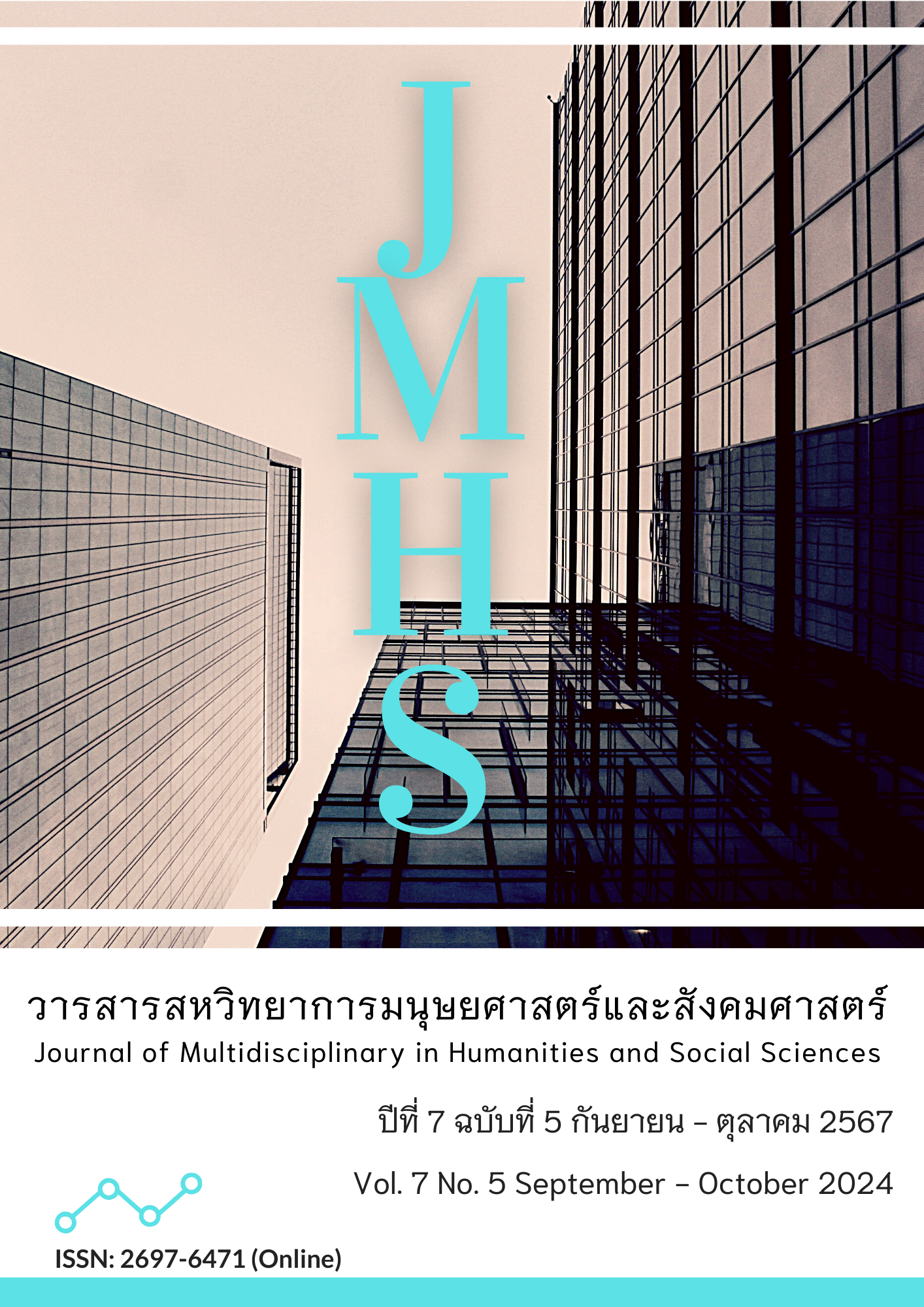การศึกษาปัจจัยพหุระดับที่มีอิทธิพลต่อความเหลื่อมล้ำของคะแนนผลสัมฤทธิ์ทางการเรียนวิชาภาษาอังกฤษ ของนักเรียนชั้นมัธยมศึกษาปีที่ 6 ที่เกิดขึ้นภายในและระหว่างสำนักงานเขตพื้นที่การศึกษาของประเทศไทย
Main Article Content
บทคัดย่อ
บทความนี้มีวัตถุประสงค์ 1) เพื่อศึกษาความเหลื่อมล้ำของผลสัมฤทธิ์ทางการเรียนวิชาภาษาอังกฤษ ที่เกิดขึ้นภายในและระหว่างสำนักงานเขตพื้นที่การศึกษา และ 2) เพื่อศึกษาปัจจัยพหุระดับที่มีอิทธิพลต่อความเหลื่อมล้ำของผลสัมฤทธิ์ทางการเรียนวิชาภาษาอังกฤษของนักเรียนมัธยมศึกษาปีที่ 6 รูปแบบการวิจัยเป็นการวิจัยเชิงปริมาณ กลุ่มตัวอย่าง ได้แก่ นักเรียนชั้นมัธยมศึกษาชั้นปีที่ 6 ของโรงเรียนในสังกัดสำนักงานเขตพื้นที่การศึกษามัธยมศึกษาในประเทศไทย จำนวน 13,646 คน ได้มาจากการสุ่มอย่างง่ายโดยใช้ตารางเลขสุ่ม เครื่องมือที่ใช้ในการวิจัย ได้แก่ แบบบันทึกข้อมูล วิเคราะห์ข้อมูลโดยใช้การวิเคราะห์พหุระดับแบบ 3 ระดับ ด้วยโปรแกรม HLM (Hierarchical Linear Model ver.8.2)
ผลการวิจัยพบว่า 1. ความเหลื่อมล้ำของผลสัมฤทธิ์ทางการเรียนวิชาภาษาอังกฤษ ที่เกิดขึ้นภายในและระหว่างสำนักงานเขตพื้นที่การศึกษา มีนัยสำคัญที่ระดับ .01 (2= 8202.565, 420.972) 2. ปัจจัยพหุระดับที่มีอิทธิพลต่อความเหลื่อมล้ำของผลสัมฤทธิ์ทางการเรียนวิชาภาษาอังกฤษของนักเรียนมัธยมศึกษาปีที่ 6 พบว่า ระดับนักเรียน ได้แก่ เพศ ระดับโรงเรียน ได้แก่ จำนวนนักเรียน ที่ตั้งในเมือง/นอกเมือง เศรษฐฐานะของโรงเรียน และระดับเขตพื้นที่การศึกษา ได้แก่ จำนวนโรงเรียน เศรษฐฐานะของเขตพื้นที่ มีนัยสำคัญทางสถิติ โดยปัจจัยพหุระดับสามารถร่วมกันทํานายผลสัมฤทธิ์ทางการเรียนวิชาภาษาอังกฤษ ได้ร้อยละ 20.11 องค์ความรู้จากงานวิจัยนี้ เป็นประโยชน์ต่อผู้บริหารโรงเรียน และผู้บริหารเขตพื้นที่การศึกษาสามารถนำปัจจัยพหุระดับที่พบไปศึกษาตามสภาพบริบทของตนเอง แล้วพัฒนาแนวดำเนินงานหรือแผนงานที่ช่วยให้ปัจจัยพหุระดับมีอิทธิพลลดลง ซึ่งจะช่วยลดความเหลื่อมล้ำของผลสัมฤทธิ์ทางการเรียนลงได้
Article Details

อนุญาตภายใต้เงื่อนไข Creative Commons Attribution-NonCommercial-NoDerivatives 4.0 International License.
ทัศนะและความคิดเห็นที่ปรากฏในวารสาร ถือเป็นความรับผิดชอบของผู้เขียนบทความนั้น และไม่ถือเป็นทัศนะและความรับผิดชอบของกองบรรณาธิการ
เอกสารอ้างอิง
กระทรวงศึกษาธิการ. (2562). พระราชบัญญัติการศึกษาแห่งชาติ พ.ศ. 2542 (รวมแก้ไขเพิ่มเติม พ.ศ. 2562). กรุงเทพฯ: สยามสปอรต์ ซินดิเคท.
กองทุนเพื่อความเสมอภาคทางการศึกษา. (2566). ขาดงบ ขาดครู ขาดโอกาส ความไม่เสมอภาคของโรงเรียนในพื้นที่ห่างไกล. สืบค้นจาก https://www.eef.or.th/article-public-policy-move-1/
ณปภัช บรรณาการ และ สิวะโชติ ศรีสุทธิยากร. (2562). ความเหลื่อมล้ำทางการศึกษาในโรงเรียนสังกัดสำนักงานเขตพื้นที่การศึกษามัธยมศึกษา กรุงเทพมหานคร. An Online Journal of Education, 14(2), 1-11. สืบค้นจาก https://so01.tci-thaijo.org/index.php/OJED/article/view/184842
เปรื่อง กิจรัตน์ภร. (2555). ความเหลื่อมล้ำทางการศึกษาไทย: ที่มาและทางออก. สืบค้นจาก https://silo.tips/download/267
รัตนะ บัวสนธ์. (2561). การพัฒนารูปแบบบูรณาการความร่วมมือเพื่อลดความเหลื่อมล้ำด้านคุณภาพและมาตรฐานการศึกษาระดับเขตพื้นที่การศึกษาสำนักงานคณะกรรมการการศึกษาขั้นพื้นฐาน. วารสารศึกษาศาสตร์ มหาวิทยาลัยนเรศวร, 21(2), 239-258. สืบค้นจาก https://so06.tci-thaijo.org/index.php/edujournal_nu/article/view/144284
ศิริชัย กาญจนวาสี. (2554). การวิเคราะห์พหุระดับ (Multi-Level Analysis). (พิมพ์ครั้งที่ 5). กรุงเทพฯ: จุฬาลงกรณ์มหาวิทยาลัย.
สังวรณ์ งัดกระโทก. (2552). คุณภาพการสอนวิทยาศาสตร์และความสามารถทางวิทยาศาสตร์ของนักเรียนไทย:ข้อค้นพบและข้อเสนอแนะเชิงนโยบายจากการประเมินนักเรียนระดับนานาชาติ (รางวัลผลงานวิจัยระดับดี รางวัลสภาวิจัยแห่งชาติ ปี พ.ศ. 2552). กรุงเทพฯ: สภาวิจัยแห่งชาติ.
สังวรณ์ งัดกระโทก. (2561). กลไกของความเหลื่อมล้ำทางการศึกษาของประเทศไทย: การตรวจสอบความเชื่อมโยงระหว่างกลยุทธ์การสอนและความเหลื่อมล้ำทางการศึกษาวิชาวิทยาศาสตร์จากข้อมูล PISA, 93-102. เอกสารประกอบการประชุมสัมมนาวิชาการการวัดผล ประเมินผล และวิจัยสัมพันธ์แห่งประเทศไทย ครั้งที่ 26, 5-7 กุมภาพันธ์ 2561, มหาวิทยาลัยขอนแก่น.
สำนักงานเลขาธิการสภาการศึกษา. (2560). แผนการศึกษาแห่งชาติ พ.ศ. 2560 - 2579. กรุงเทพฯ: พริกหวานกราฟฟิก.
สำนักงานคณะกรรมการการศึกษาขั้นพื้นฐาน. (2561). แนวทางการดำเนินงาน การสนับสนุนค่าใช้จ่ายในการจัดการศึกษาขั้นพื้นฐาน ตามโครงการขยายโอกาสการเข้าถึงบริการทางการศึกษาและการเรียนรู้ตลอดชีวิตอย่างทั่วถึงและมีคุณภาพ ปีงบประมาณ พ.ศ. 2561. สืบค้นจาก http://www.secondary39.go.th/
สำนักงานคณะกรรมการข้าราชการครูและบุคลากรทางการศึกษา. (2564). โรงเรียนเล็กหรือใหญ่คุณภาพการศึกษาไทยต้องเท่าเทียม. สืบค้นจาก https://www.youtube.com/watch?v=mxHrbh6IqAc
สำนักงานนวัตกรรมแห่งชาติ. (2566). แผนยุทธศาสตร์การดำเนินงานของสำนักงานนวัตกรรมแห่งชาติ พ.ศ. 2566-2570. สืบค้นจาก https://www.nia.or.th/strategy
สำนักงานสภาพัฒนาการเศรษฐกิจและสังคมแห่งชาติ. (2566). แผนพัฒนาเศรษฐกิจและสังคม (พ.ศ. 2566-2570). สืบค้นจาก https://www.nesdc.go.th/ewt_news.php?nid=13651&filename=develop_issue
Elohanan, C. (1982). Financing schools. Encyclopedia of Educational Research, 3(4), 695-696.
Fry, G. W. (2018). Education in Thailand: An Old Elephant in Search of a New Mahout. Singapore: Springer.
Raudenbush, S. W., & Bryk, A. S. (2002). Hierarchical Linear Models: Applications and Data Analysis Methods. California: Sage.


